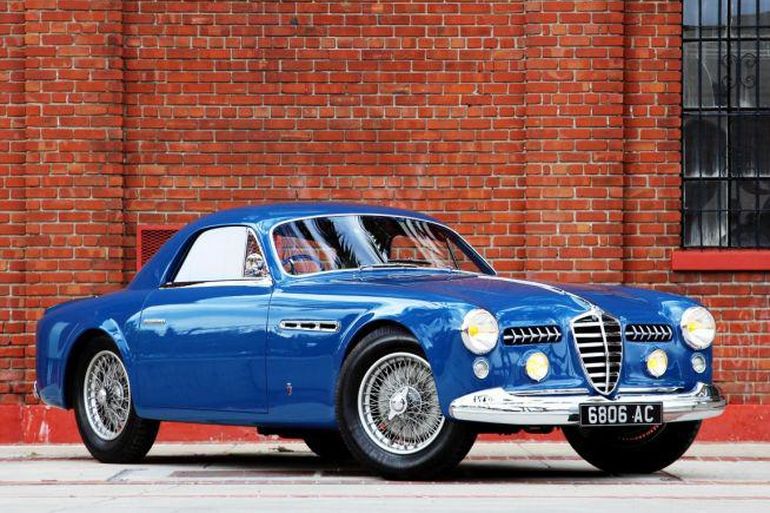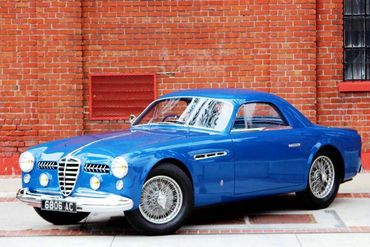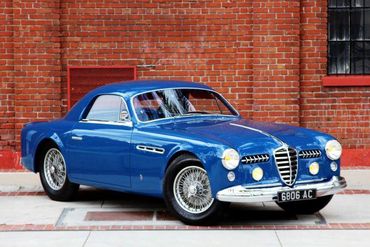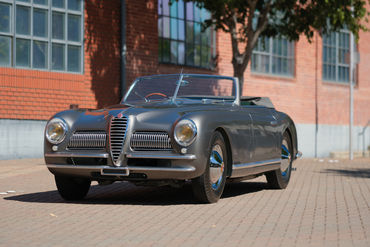Sold
SOLD 04/16
1950 Alfa Romeo
6C 2500 Supergioiello by Ghia
Magnificent Coachbuilt One-Off by Ghia in Super Sport Configuration. Ideal for Concours and Rally Events.
- VIN64251
- Exterior ColorBlue
- Interior ColorLight Blue Leather
- Mileage6369 Miles
- Engine2.5 Litre DOHC 6-Cylinder
- Engine no.924866
- Transmission4-Speed
- StatusSold
- StockFJ1929
Description
1950 Alfa Romeo 6C 2500 Supergioiello by Ghia
s/n 0064251, engine no. SS924866
Blue with Light Blue Leather
A development of the legendary 6C 2300, the 6C 2500 was available in a variety of trims, including the standard long wheelbase model, as well as the shorter wheelbase Sport and Super Sport models. Among the most expensive cars available at the time, they represent Alfa Romeo’s old-style, elegant, glamorous, and exclusive cars and were developed under Vittorio Jano. The specification is accordingly sophisticated, including dual overhead cam engine, independent suspension all round, and hydraulic brakes. Alfa Romeo ambitiously raced the 6C 2300 and 2500 following their introduction, amassing an impressive string of victories and podium finishes including 1-2 in the 1937 Mille Miglia, 1-2-3 in the 1937 6 hour Targa Abruzzo at Pescara backed up by another Pescara win in 1938. Successful races continued after the cessation of WWII hostilities, including an overall win in the 1950 Targa Florio.
Postwar Italy was a time of great creativity on the part of a great many specialty builders. Although most used components taken from smaller vehicles produced great numbers, a few elected to utilize Alfa Romeo 6C2300, 6C2300B and 6C2500 components. Some of these components were available new from Alfa Romeo. Some cars and parts were made available as \"spoils of war\" (oftentimes left behind by retreating troops or by displaced families) and because of left-over military hardware that had not yet been placed into service. Alfa Romeo 6C2500 engines had been made in small numbers for the Italian military's use in a small number of vehicles and also for marine use. Those military engines were designed to use dry-sump oiling, perhaps more for packaging reasons than for racing, but the dry-sump system itself had appeal also to those who wished to go racing.
Competition oriented Alfa-powered Specials were not unusual in period. Pasquino Ermini, builder of quite a number of special cars in Florence, raced himself beginning 1947 in a racing special that could use either a highly tuned Fiat engine or a tuned 6C2300 engine enlarged most likely to something similar to (or larger than) 6C2500 specifications. Nardi & Danese (Turin) built at least 4 6C2500 powered examples from 1948-1949 on a tube-frame chassis of their own design, some of which were purchased from Gilco. Those cars were raced in the Mille Miglia, Targa Florio and other events. A 6C2500 engine was used in tubular-chassis car purpose-built in Rome called \"AMP 3000\" on its first 1949 appearance on the Mille Miglia with Giovanni Rocco. Rocco went on to race it elsewhere as well. Luigi Plate' built a tubular chassis during 1948 to use a 6C2300 engine. He completed his special car during 1949. Although Plate' had done a fair bit of racing both pre-war and post-war, this car was completed as a road-going sports car ... even if it raced at least once. A 1950 Gilco design was done as a special project for a \"CABI-Cattaneo\" coupe that was bodied by Riva to a design drawn by Gianni Lurani.
Each of the 6C2500-based projects was quite special. Although each was an independent project not always involving Alfa Romeo directly, they are indicative of a portion of car-building culture of the time. Most customers settled for something from a well-known builder. Each of these cars was built by someone who had a vision to have something personal that was not available from any large-scale builder.
This chassis shares the 2700mm wheelbase length of the 458 \"SuperSport\" chassis from Alfa Romeo. The engine is numbered \"SS924866\", with SS being the abbreviation for “SuperSport”, the specification of this example is effectively identical to Alfa Romeo’s most sporting 6C 2500s of the era. Interestingly, it is the only similarly \"924xxx\" numbered engine identified thus far as being completed to the SS specification which includes three Weber 36DO3 carburetors. It is also the highest number known in the \"924xxx\" engine number range. Both of these characteristics (taken together) imply that the engine may well have been purchased directly from Alfa Romeo for this project and may have been specially prepared at Alfa Romeo before delivery.
This particular car has fascinating history and is a one-off Ghia-bodied example originally ordered by SIRCA, the dealer in Milan that served as Carrozzeria Ghia’s representative for the region of Lombardy. This firm served as the promoter for Ghia’s Supergioiello (meaning “Super Jewel”) cars, a style of body typically fitted to the Fiat 1100 chassis, but also available for the Alfa Romeo 6C 2500. It is understood by experts that four Supergioiello 6C 2500s were built, all on Alfa Romeo chassis except one. This chassis was instead ordered from GILCO, Gilberto Colombo’s chassis design, experimentation, and manufacturing firm responsible for a variety of interesting special construction and engineering projects such as the first Ferraris, including the first Ferrari built, the 125. This collaboration lasted through Ferrari’s first 10 years of existence and Gilco’s firm also did work for other manufacturers including Lancia, Maserati, and of course Ghia. The result of this is that, unlike the Alfa Romeo’s prewar chassis, this car employs more modern construction by one of the period’s eminent firms. The running gear, suspension, and brakes are all period 6C components which appear to date primarily from 1948.
With that relationship in mind, SIRCA ordered this car, which was built sometime prior to 13 March 1951, as indicated by a letter from GILCO to the Minister of Transport in Milan, which is responsible for issuing special permits for non mass-produced cars. The letter describes five cars built by GILCO: two 1100 Sports, two 750 Sports, and this 6C 2500.
Truly a specialty coachbuilt car, likely designed in a no-expense-fashion, both the interior and exterior display numerous unique art deco details. As a contrast to nearly every other Alfa Romeo grille from before or after, this car employs a unique shape to the radiator inlet and frontal area. As is common to Ghia designs, the sides are relatively stark, but accented by triple port holes and recessed door handles. The wheel arches display muscular flairs, and the roofline is elegant and swooping with a rakish, curved windscreen. The engine lid has very special air inlets that are so subtle and delicate that if not chromed, they would go unnoticed. The gauges, switchgear, and interior levers are decidedly art deco in their design, and exceedingly special. The more time the admirer spends with the car, the more there is to admire.
The car’s first few years of history are not well known, but it made its way to the United Kingdom, where it was first registered on 7 August 1959. The original log books from this period are included with the car, and include several ownership changes, with the car being registered in Somerset, Bristol, and London. A copy of a January 1961 advertisement shows the car on offer for £895 with “Bunny Garage” in Nottinghamshire. The car is shown in a black and white photograph to be white with a darker roof and chrome wheel covers resemble the Lmarr type, and the ad describes the car as blue/white. Another period black and white photo shows the car in the same configuration.
The log books show the car’s continued existence in the United Kingdom over the subsequent decades, including the same family (father then son) from 1971 until October 1995, when the car was offered at auction by Brooks at Earls Court, when it was white with blue interior and intact but needing restoration. The car was sold to an owner in Austria, who set about performing a comprehensive high caliber restoration which took approximately 5,800 man hours. Several photos from before and during the restoration are included with the car. The car appeared in freshly completed form at Villa d’Este in 1997. It was displayed there again in 2001, where it achieved a class win and second prize overall. Since the car’s restoration, it has belonged to enthusiastic collectors, including the same Northern California collector twice, who bought it at Christie’s Pebble Beach auction in 2004, and sold the car via Fantasy Junction in 2007. He later repurchased the car after it spent some time with an owner in the Netherlands.
Today, the car still displays an excellent cosmetic presentation. The body is in phenomenal order, with straight panels and outstanding gaps throughout. The paintwork is beautiful in its luster, with only very minor wear evident on some of the edges of the opening panels. The glass is generally excellent, as are the emblems and lenses (including the beautiful Marchal yellow head and driving lights). The brightwork has aged gracefully, and shows only the most minor weathering on select surfaces. The upholstery remains very nice, and the one-off deco gauges and switchgear are excellent. Ghia designed this example with a generous trunk storage space, a handy attribute for tour and rally event use.
This Alfa 6C 2500 is exceptionally enjoyable on the road. It starts easily, and makes excellent power. Throttle response is immediate, and the rotating mass of the engine feels well balanced, but also lighter than most Alfas of this configuration we have had the opportunity to experience. The brakes are as effective as any from the era, and the steering geared quickly giving a competition-inspired feel. The all-synchromesh gear change is operated by way of the very slick column mounted lever, and has an affirmative feel. The chassis itself is well composed over rough surfaces, and has a robust, well balanced feel. The body provides for excellent ergonomics and visibility for the occupants, further confirmation of the outstanding design corroboration between Ghia and Gilco.
Included with the sale is the British logbook, a copy of the original chassis drawing, a photo essay of the restoration, several old photos, and other historical documents from the 1960s and 1970s provided by Alfa Romeo 6C 2500 authority Raoul Sna Giorgi.
Boasting exclusivity, this coachbuilt post-war sports car would be a welcome entrant to the world’s premier concours venues, but as an enclosed, all-weather coupe with excellent ergonomics and ample storage space, the tour and rally opportunities are also plentiful. Theoretically eligible for the Miglia Mille Historica as 6C 2500s completed there in period, and certainly eligible for the California Mille, Colorado Grand, and numerous other pre-1957 events the world over, this magical one-off example will offer its new owner a host of experiences, and does so in an unparalleled art deco style.
The above vehicle information is complete and accurate to the best of our knowledge at the time it is posted to this website. Corrections or additional information is always appreciated. All advertised prices exclude government fees and taxes, any finance charges, any dealer document preparation charge, and any emission testing charge. Vehicles are subject to prior sale. All advertised to be true but not guaranteed. We assume no liability for errors or omissions.
Inquire About This Car
Fantasy Junction • 510-653-7555 • 1145 Park Ave, Emeryville, CA 94608



